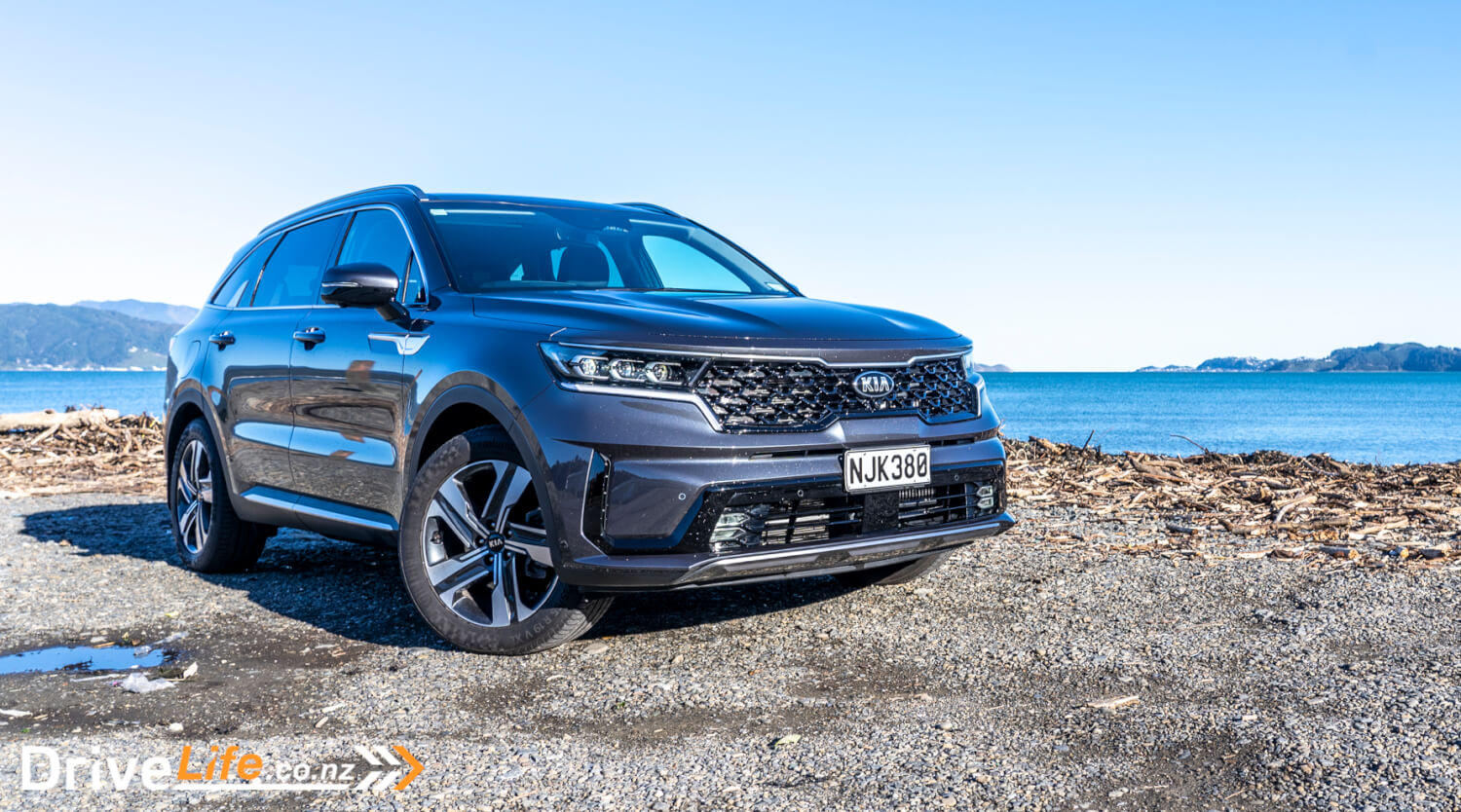If we are all being honest, I think there was a large gasp when Kia released the pricing for their latest plug-in hybrid electric vehicle (PHEV) SUV. At near-on $90,000 for the top-spec model, this is the most expensive Kia ever. But then if you compare it to its sister car, the diesel-turbo Hyundai Santa Fe, in the top-spec model that car is exactly the same price.
Last month, Alistair reviewed the AWD Sorento Premium with its 2.2-litre diesel-turbo and he was very impressed – regardless that that car cost $76,990.
Is it worth stumping up another $13,000 to move from the Kia Sorento Premium diesel to the same spec model but as a PHEV?
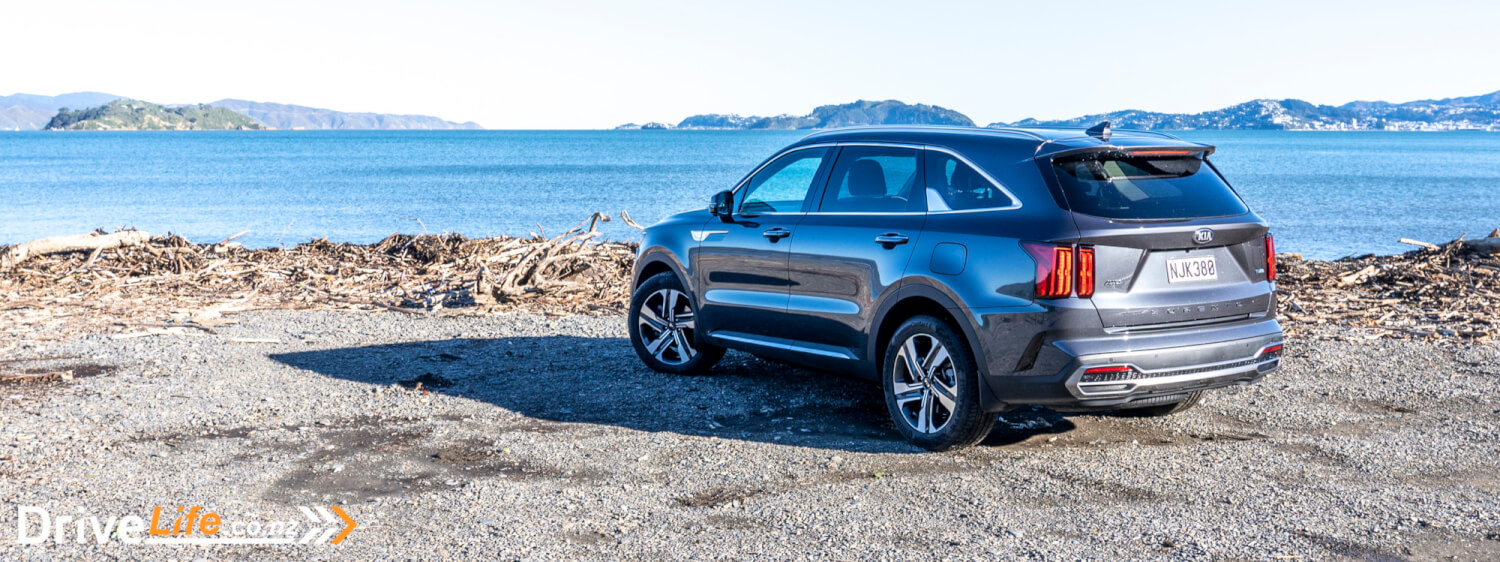
What’s in the 2021 Kia Sorento Premium Range?
As per Alistair’s review, this new Sorento marks the 4th generation of the model. It’s a new design and is built on the Hyundai-Kia N3 platform. The N3 platform is shared with the Hyundai Santa Fe, as well as the Kia Carnival.
The Sorento is traditionally the sibling of the Hyundai Santa Fe, and shares core pieces between the two vehicles.
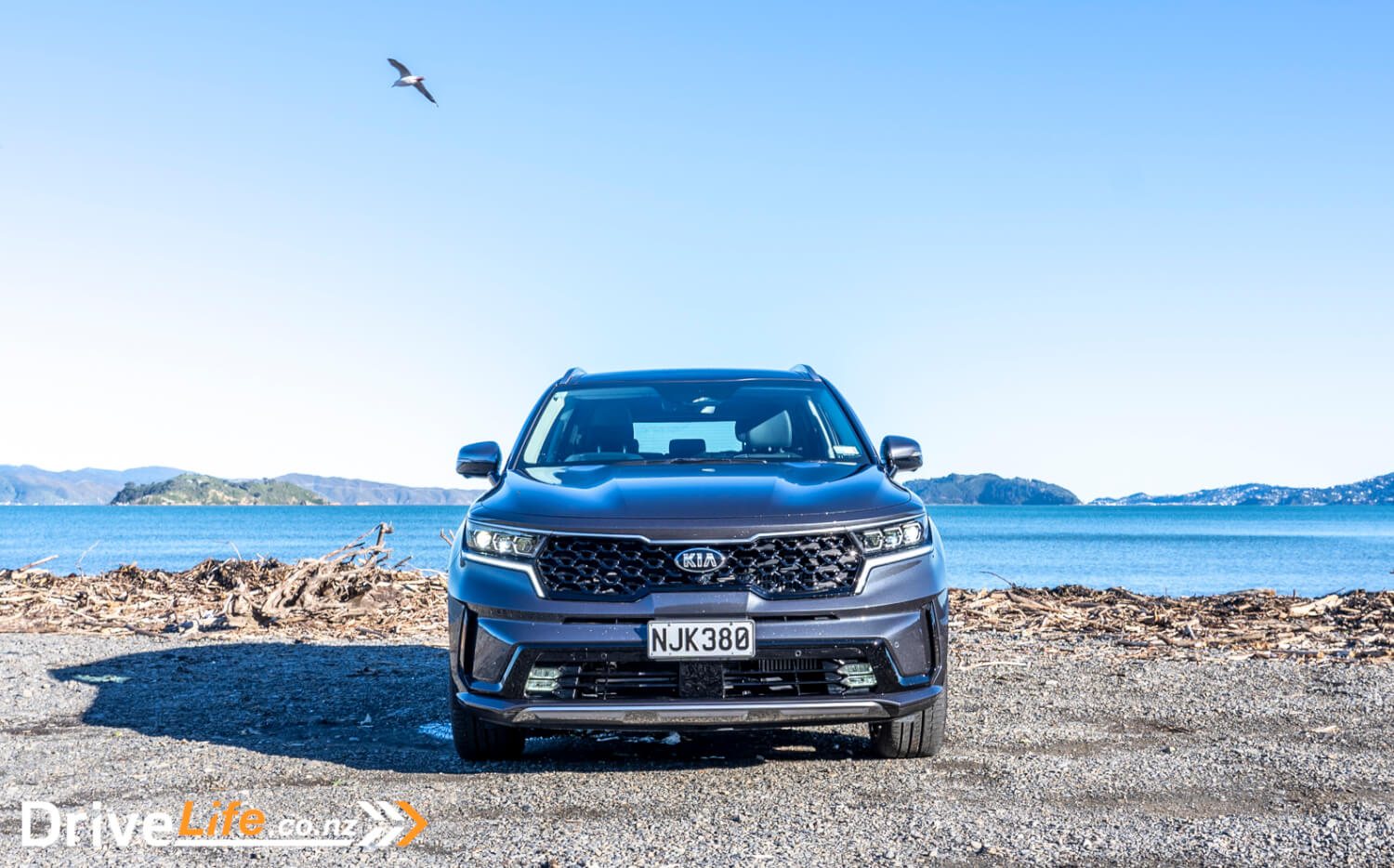
Kia appears to be making a big play for the New Zealand market, with up to 10 variants of the Sorento available. This includes a range of diesel, petrol hybrids and a plug-in hybrid (PHEV) option. These are priced below;
| Model | Engine | Drive | Price |
| LX | 2.2-litre Diesel (148kW/440Nm) | AWD | $59,990 |
| EX | 2.2-litre Diesel (148kW/440Nm) | AWD | $63,990 |
| Deluxe | 2.2-litre Diesel (148kW/440Nm) | AWD | $69,990 |
| Premium | 2.2-litre Diesel (148kW/440Nm) | AWD | $76,990 |
| EX | 1.6-litre Petrol Hybrid (169kW/350Nm) | 2WD | $63,990 |
| EX | 1.6-litre Petrol Hybrid (169kW/350Nm) | AWD | $65,990 |
| Premium | 1.6-litre Petrol Hybrid (169kW/350Nm) | 2WD | $80,990 |
| Premium | 1.6-litre Petrol Hybrid (169kW/350Nm) | AWD | $82,990 |
| EX | 1.6-litre Petrol Plug-In Hybrid (195kW/350Nm) | AWD | $74,990 |
| Premium | 1.6-litre Petrol Plug-In Hybrid (195kW/350Nm) | AWD | $89,990 |
The Sorento lineup comes equipped with an array of standard features, and the Premium models tops the spec sheet. Our Sorento Premium PHEV features a 14-way power driver’s seat including 4-way lumbar support, cushion extension and two memory settings, 10-way power front passenger’s seat including 2-way lumbar support, 19″ alloy wheels, panoramic power sunroof, Parking Collision-Avoidance Assist, blind spot collision avoidance assist, Blind Spot View Monitor, Lane Keep Assist & Lane Follow Assist, front & rear parking sensors, rearview camera with dynamic guidelines, Advanced Smart Cruise Control, LED front headlights & LED Daytime Running Lights, leather interior seat trim, audio system featuring 10.25-inch colour LCD touchscreen with split-screen function, a 12.3-inch colour TFT LCD instrument cluster, SatNav with Live Traffic Updates, wireless smartphone charging (Qi), a BOSE Premium Sound System with 12 speakers, 7 x USB Charging Ports, and a Smart Power Tailgate (Height Adjustable).
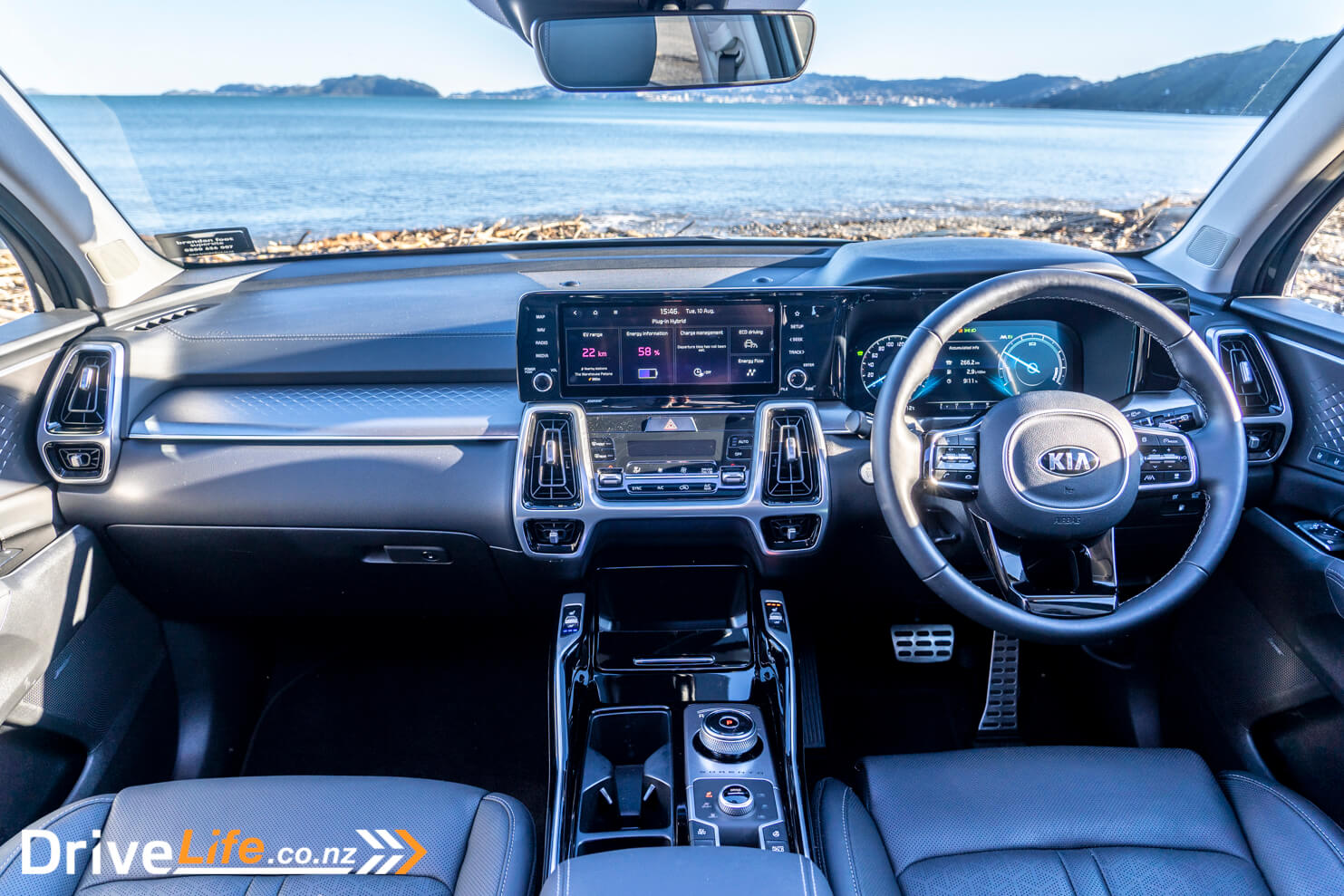
So the wheels are 1” smaller when compared to the diesel Premium Sorento, and gone is the Smart Parking where you can move the car in and out of a tight car spot using the key fob.
A diesel Sorento is powered by a 2.2-litre CRDi turbodiesel engine outputting 148kW of power and 440Nm of torque. The engine is paired with 8-speed dual-clutch transmission, with an e-shift dial (shift by wire). Underneath, power is vectored through an Active AWD system (with part-time lock modes).
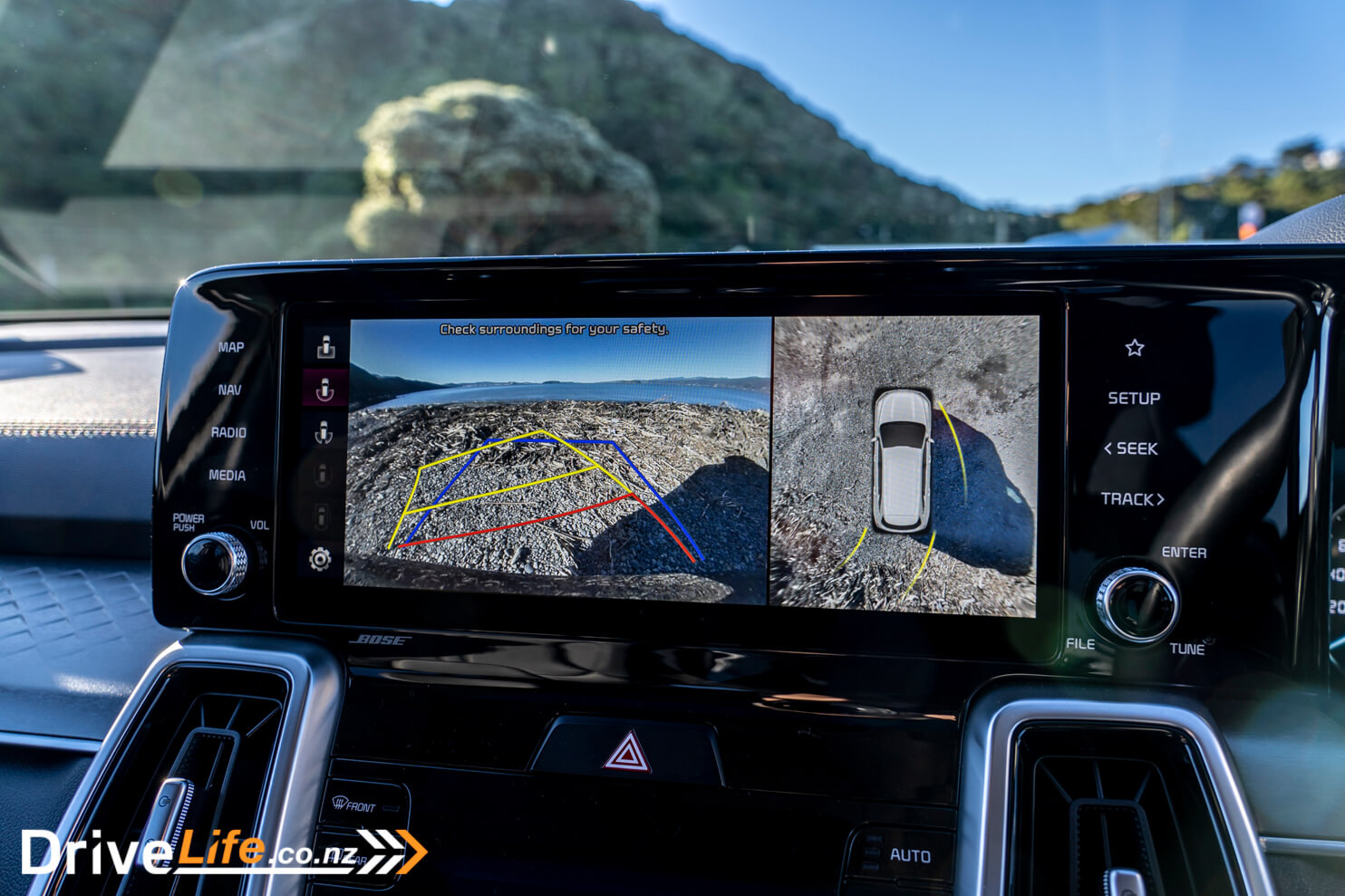
The PHEV models are powered by a 1.6-litre turbocharged petrol engine with a 13.8kWh battery pack that provides a combined 195kW of power and 350Nm of torque, with CO2 emissions of 36g/km. It has a 6-speed automatic transmission.
You get to pick from six different colours; Mineral Blue, Snow White Pearl, Platinum Graphite, Steel Grey, Aurora Black Pearl and Runway Red.
For more information on the Sorento line-up, visit the Kia New Zealand website.

First Impressions Of The 2021 Kia Sorento Premium PHEV
I have to agree with Alistair’s comments about the conservative styling of the car, especially compared to its sister car, the Hyundai Santa Fe. It’s certainly not boring, but not as in your face as the Santa Fe.
But then the rear end of the new Sorento is a nice styling exercise, in my view. For some reason, those taillights grab my eyes every time I see them. They’re different but pleasing, and in a sea of SUVs, that’s a good thing.
I don’t know why, but it seems at least 50% of the cars I review are grey or silver. They’re dangerous “colours” on the road, and they fade into the road with all the other silver and grey cars. For me, the Sorento is a good-looking car but please, if you’re going to buy one, buy one in an actual colour. Our test car was finished in Platinum Graphite, or dark grey.
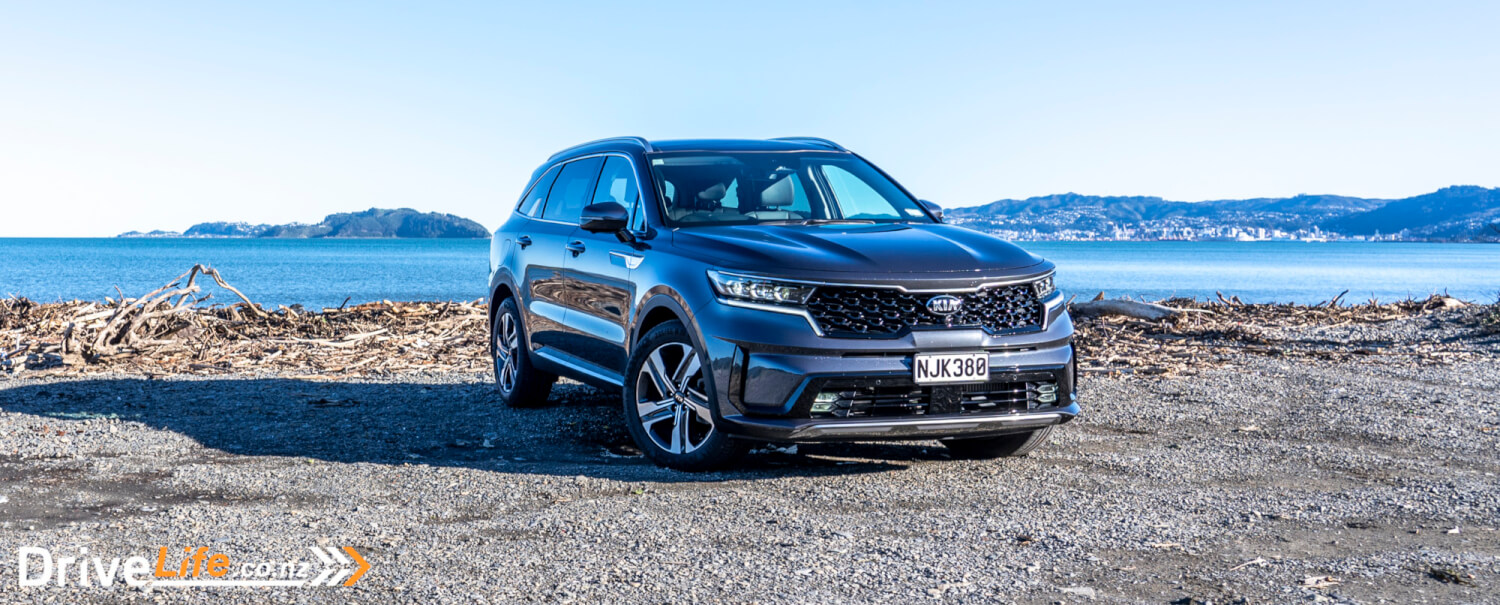
What’s The Interior Like On A 2021 Kia Sorento Premium PHEV?
So very stylish – you could imagine you are sitting in an Audi SUV, not a Kia. The materials used are awesome, everything feels expensive, the textures flow nicely and the whole interior exudes quality. The fit and finish is excellent, as it should be at $90K. Minimalism doesn’t seem to make an appearance in the Sorento: there are buttons everywhere. I had just moved from the VW Tiguan, and it was the opposite, so the airplane-cockpit feeling was enhanced for me.
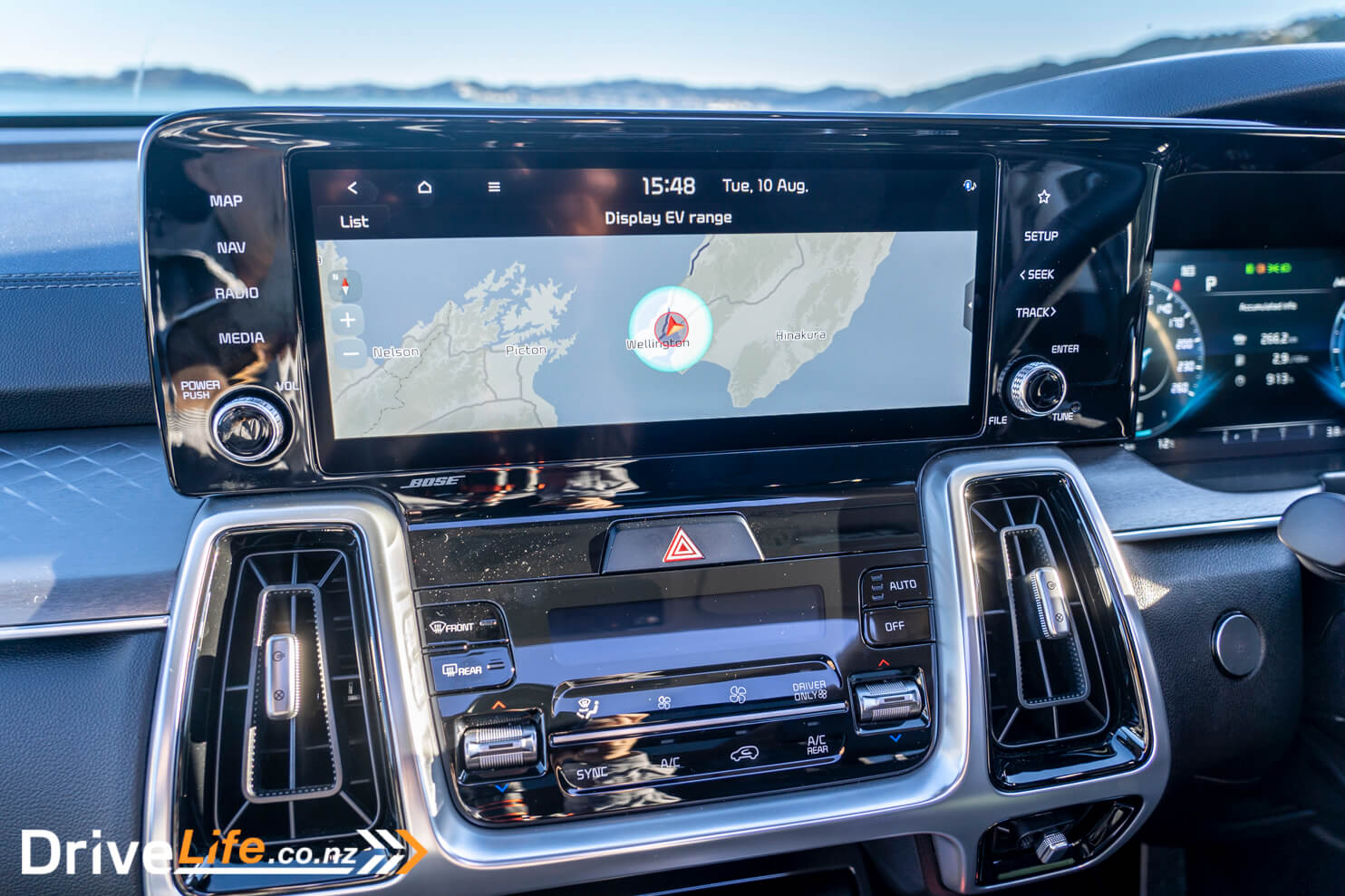
One thing I wasn’t expecting was all the piano black trim. And it’s all on the touchpoints in the car, like the centre console. After a week, the console was all spotty with fingerprints. I love piano black, but more when it’s used in the right places. One of the reasons the console got marked so much is that the heated steering wheel button is there. We had a very cold spell during my time with the Sorento PHEV, and I used the heated wheel a lot. A shame the heated wheel button isn’t right there on the wheel, where it should be.
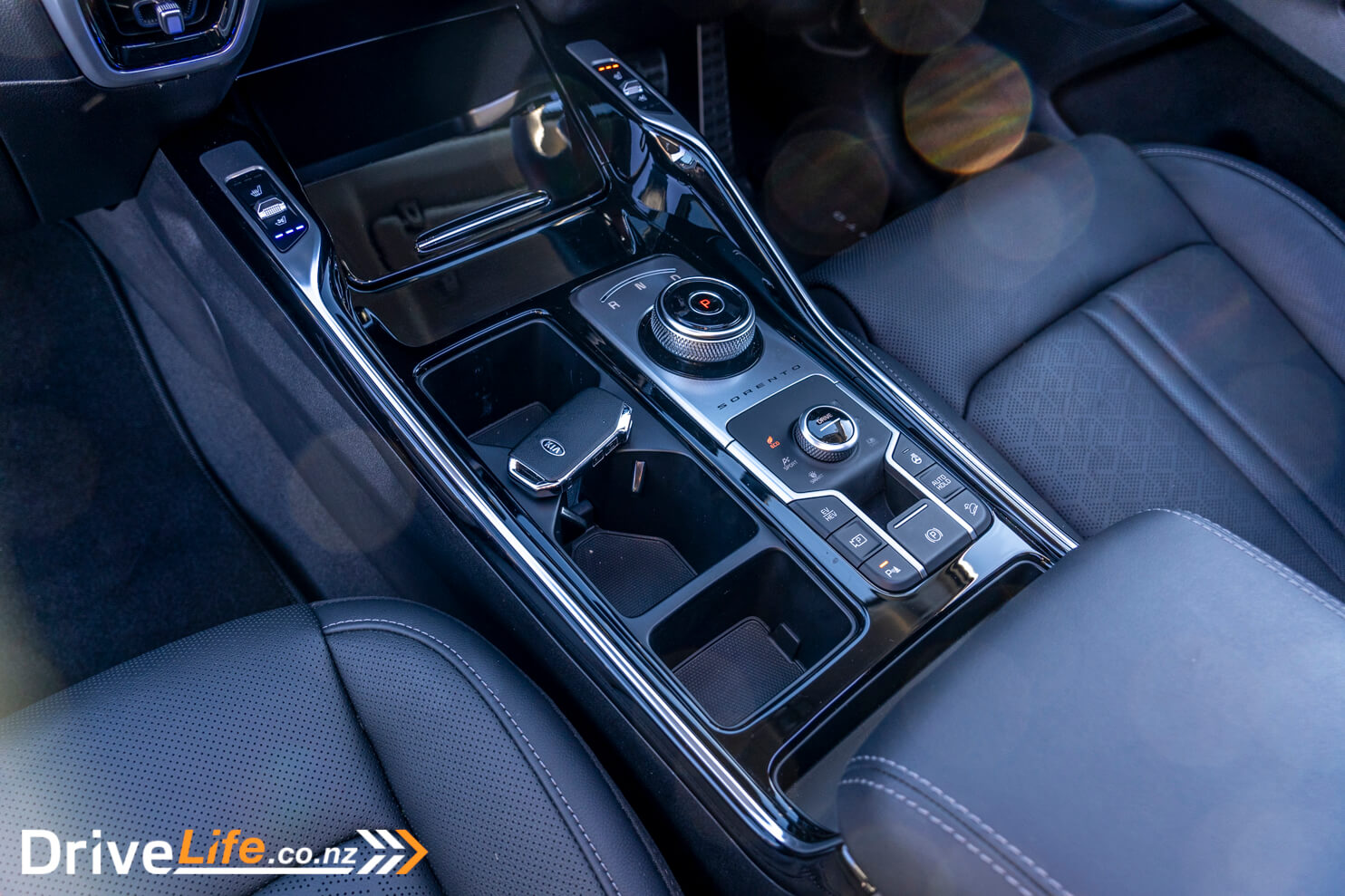
One thing I do love about the new Sorento is the double air vents across the dash. This is a rarity, and it means that I can have air blowing on my face or body, and point the smaller one down. Or I can have some cool air to my face, and redirect the smaller one to my body or legs. There are 4 lots of double vents up front, and they are awesome. There’s also heated/ventilated front seats, using a single toggle switch.

Nice to see that the Sorento PHEV is still a 7-seater, so it has one over the Outlander PHEV here. While the Outlander range are 7-seaters, the PHEV model is not. Mind you, now that it’s on a runout sale, the Outlander PHEV is $27,000 less than the Sorento PHEV.
Kia manages to keep the car as a 7-seater due to the battery location, as they’ve placed it under the front seats and it runs across the transmission tunnel.
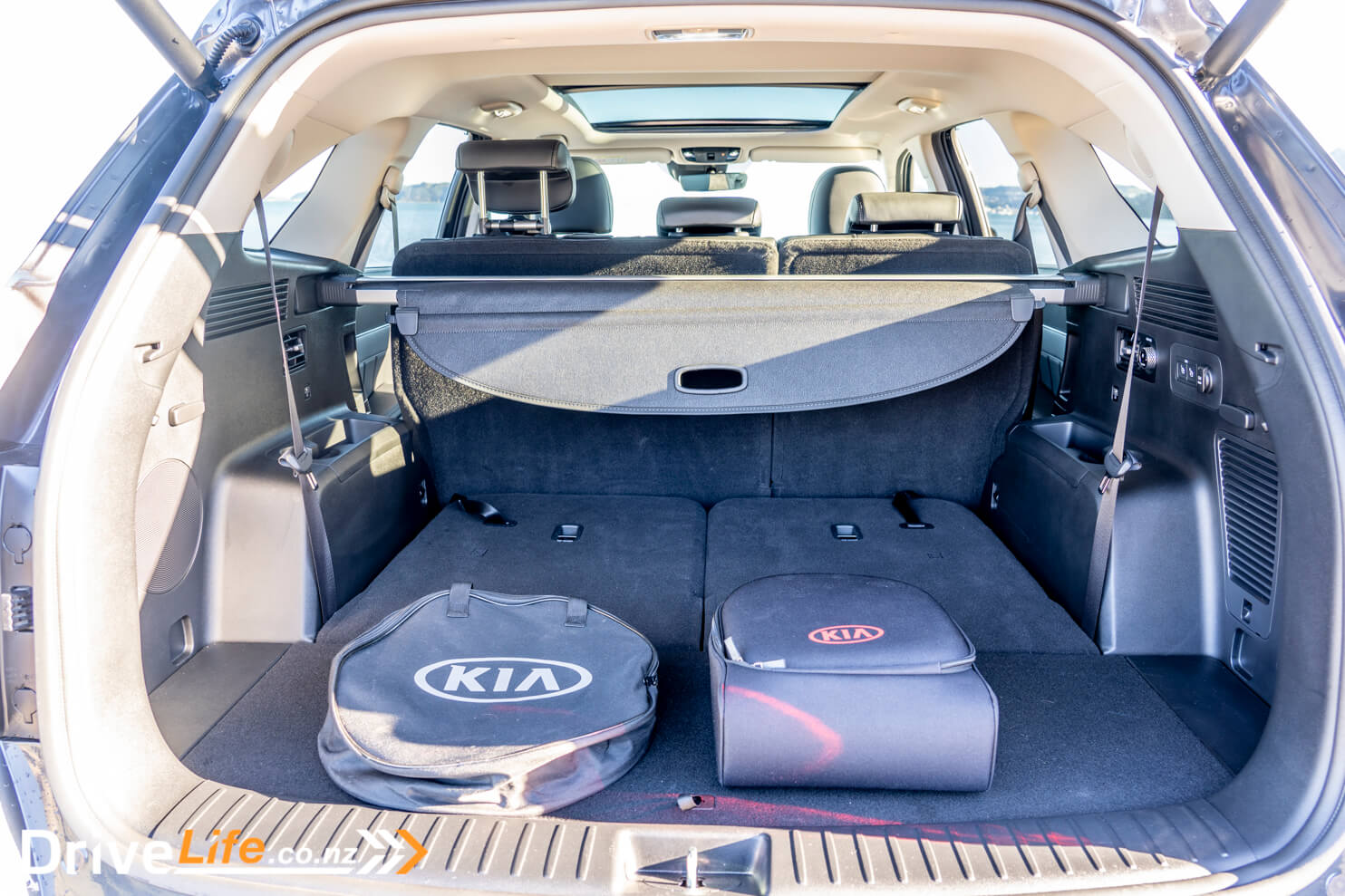
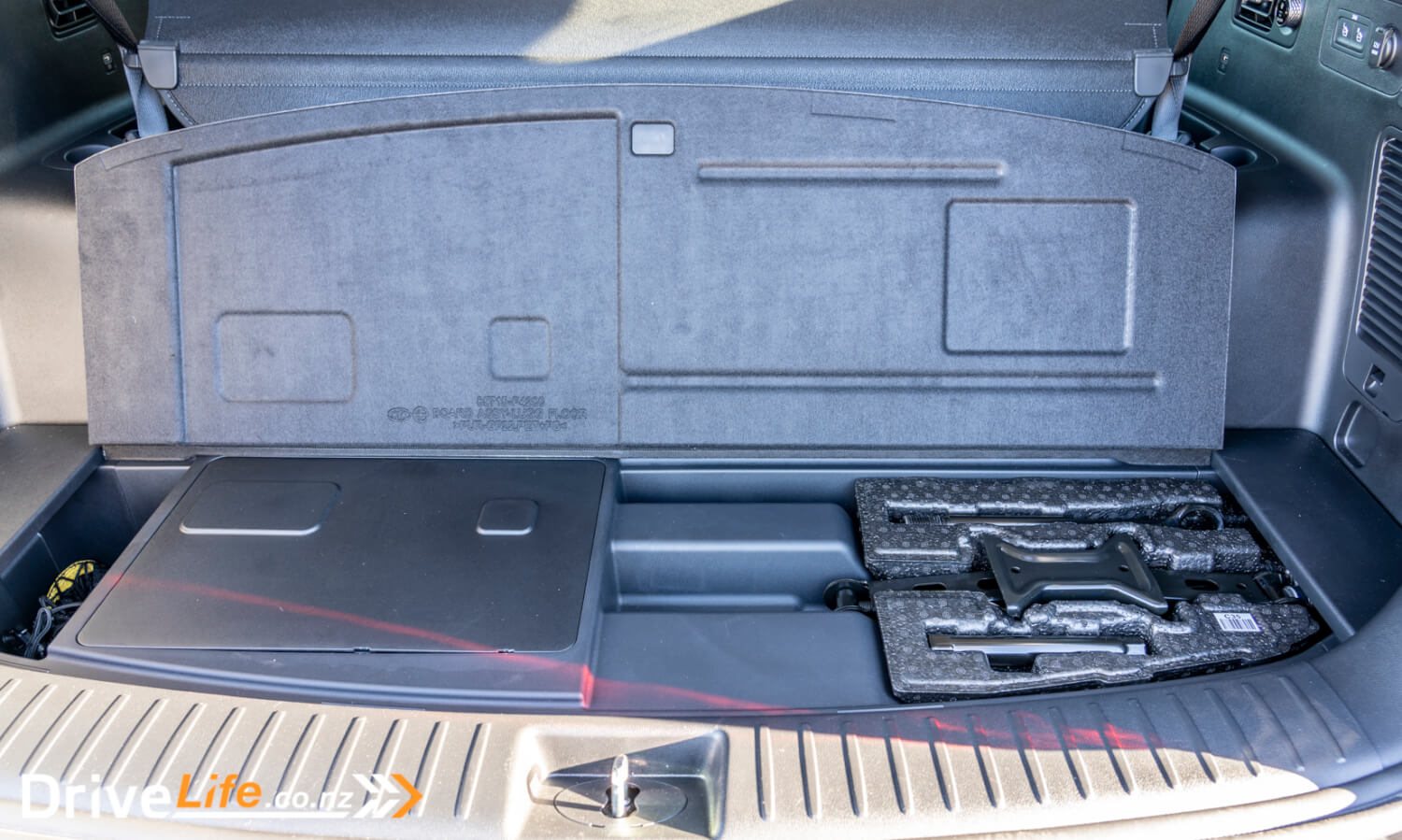
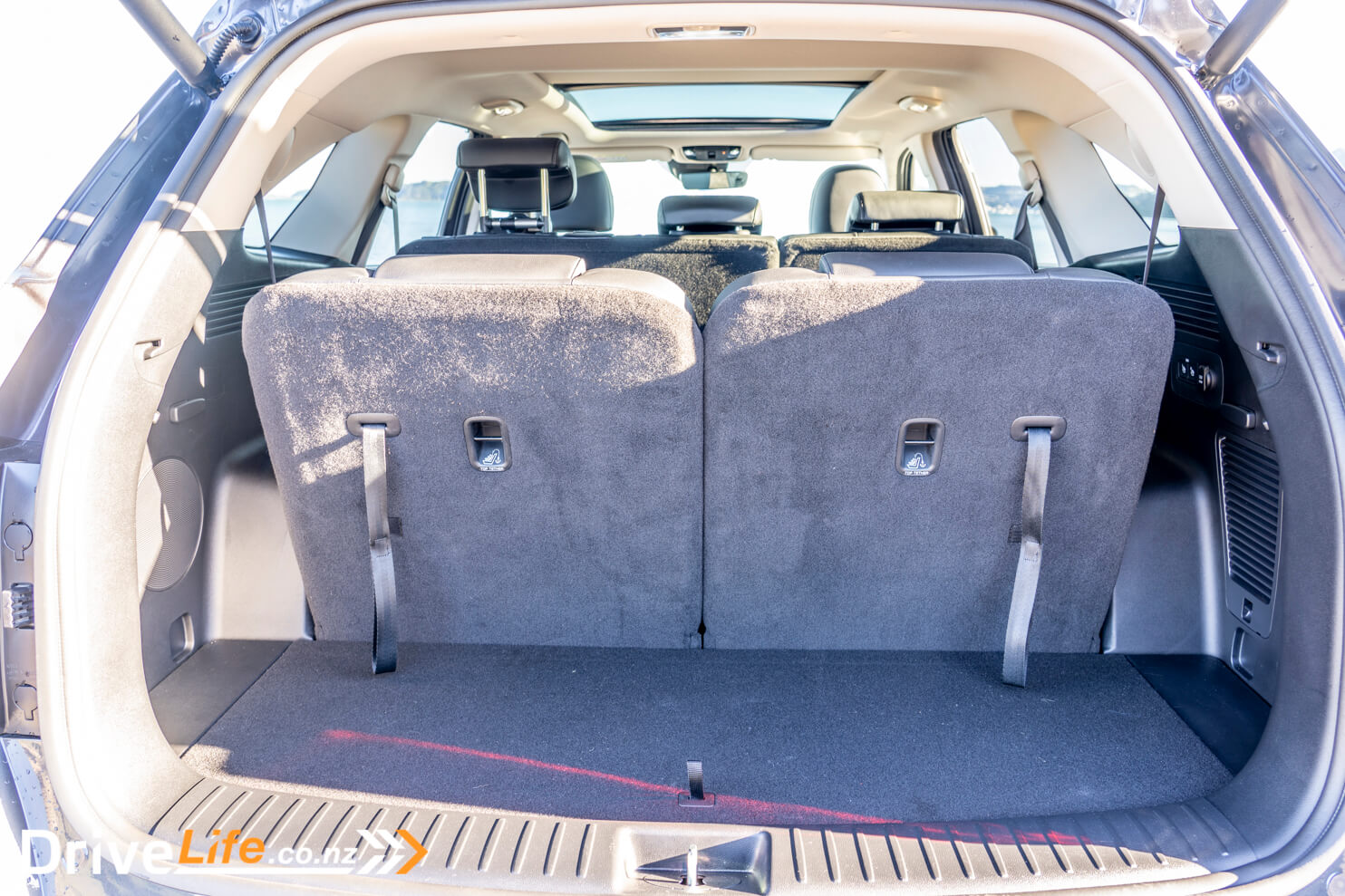
There are 3 USB ports upfront, which is a nice surprise. In the back, rear-seat passengers have window blinds, and the second-row seats are also heated which my passengers enjoyed very much. Also appreciated in the second row are the cup holders, right up there on the doors at arm height. Perfect height and location and I hope we see more of these.
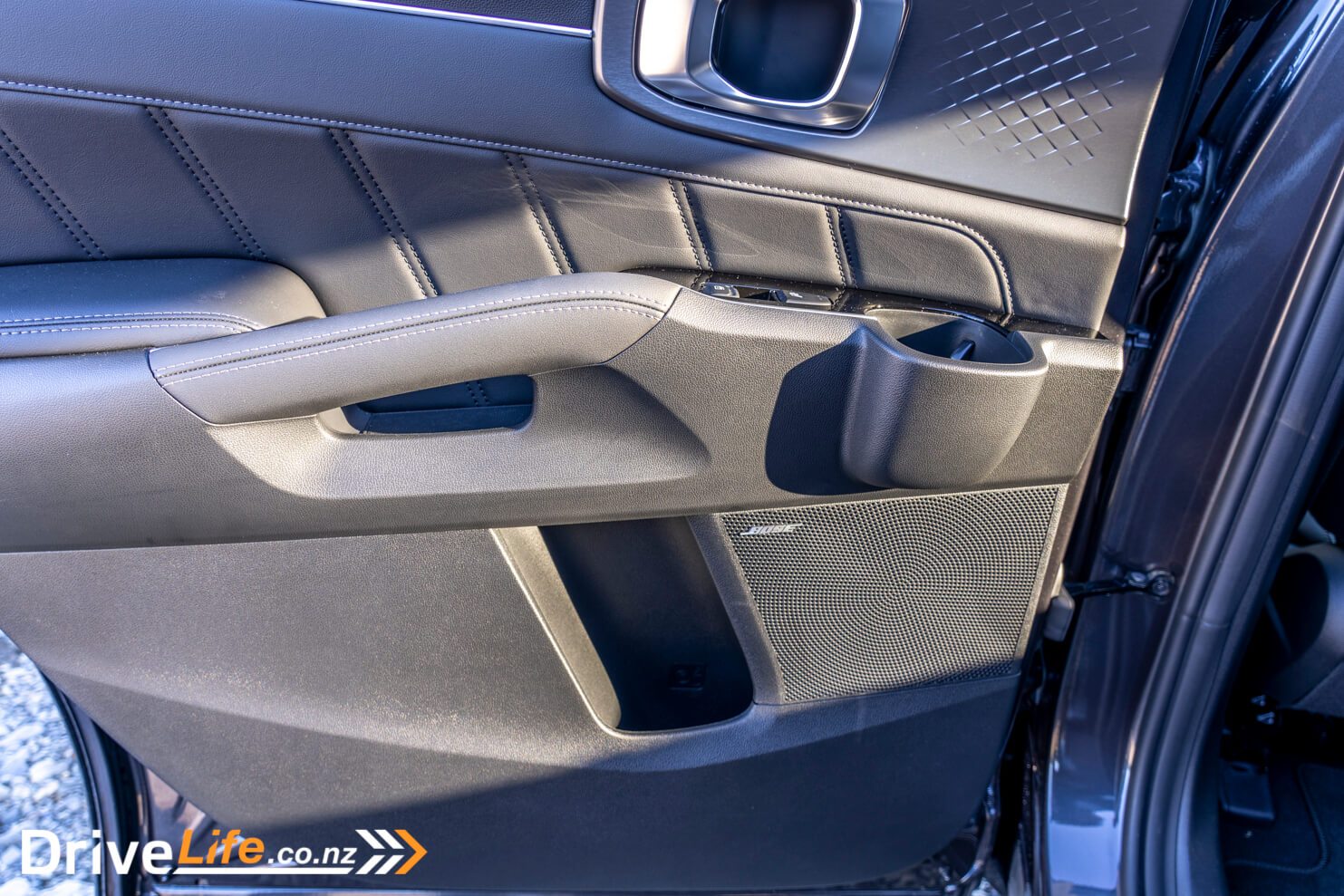
Since the battery pack for this car is up between the driver and passenger, load space is unaffected. It does make you wonder why other manufacturers aren’t following this design, as the whole rear of the car is almost identical to the diesel version, with only a slight reduction in cargo space. Way to go, Hyundai. And there is plenty of space back there, although with the third row up there’s not much space left, but this is still more than some other 7-seaters out there.
Third-row passengers have limited legroom, but again this is par for the course. All rows have lots of features and toys; vents, USB ports etc are in abundance.
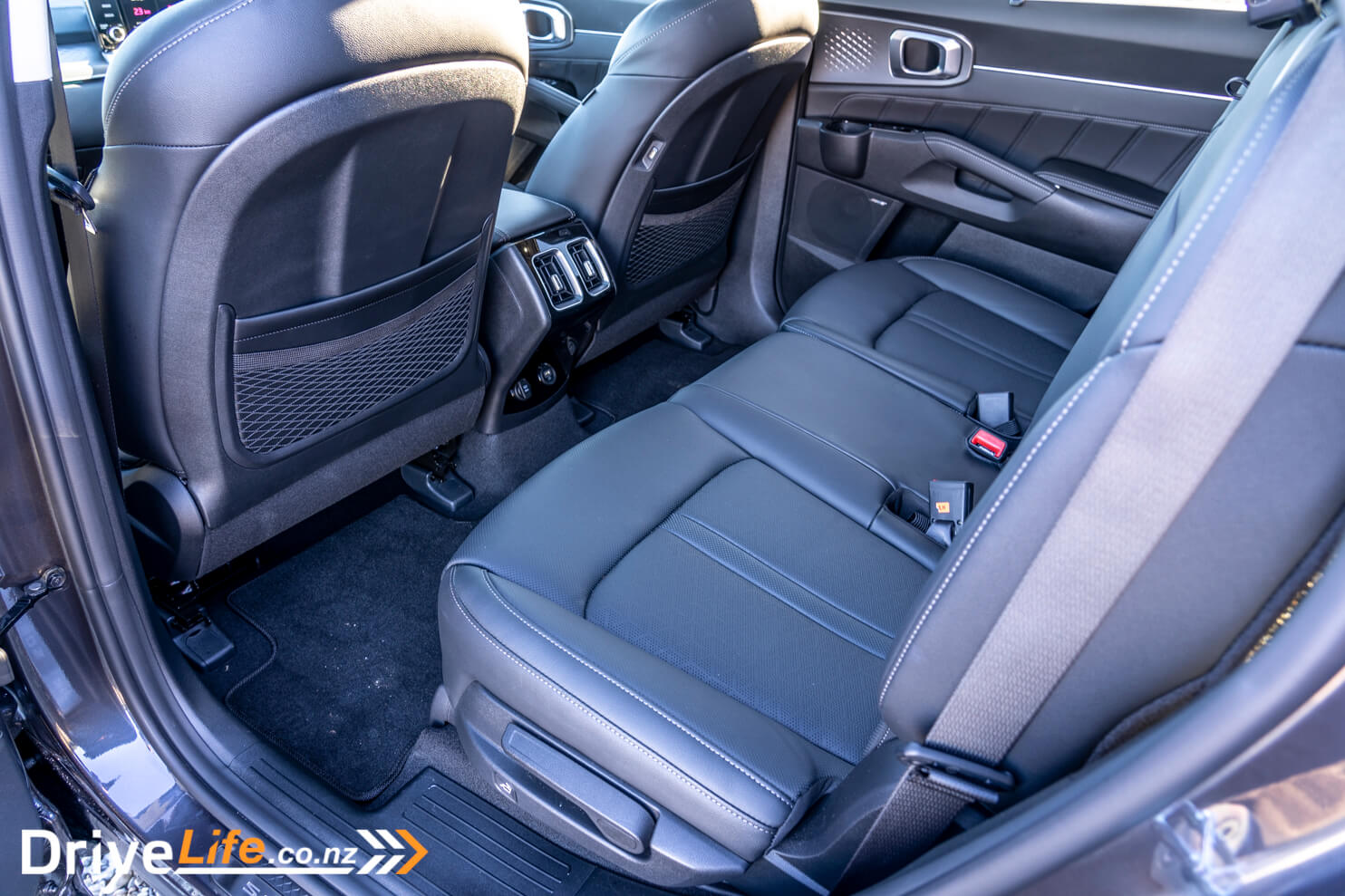
What Does the 2021 Kia Sorento Premium PHEV Drive Like?
Since Alistair did a full review on the Sorento Premium diesel, I’m going to angle this more towards the car being a PHEV, as that’s what people likely want to know. When I picked the car up it was 100% charged and had 46km of range in EV mode and showed 468Km of range on a full tank of petrol. That petrol range doesn’t seem a lot, but keep in mind this big, heavy SUV has only a 47-litre fuel tank.
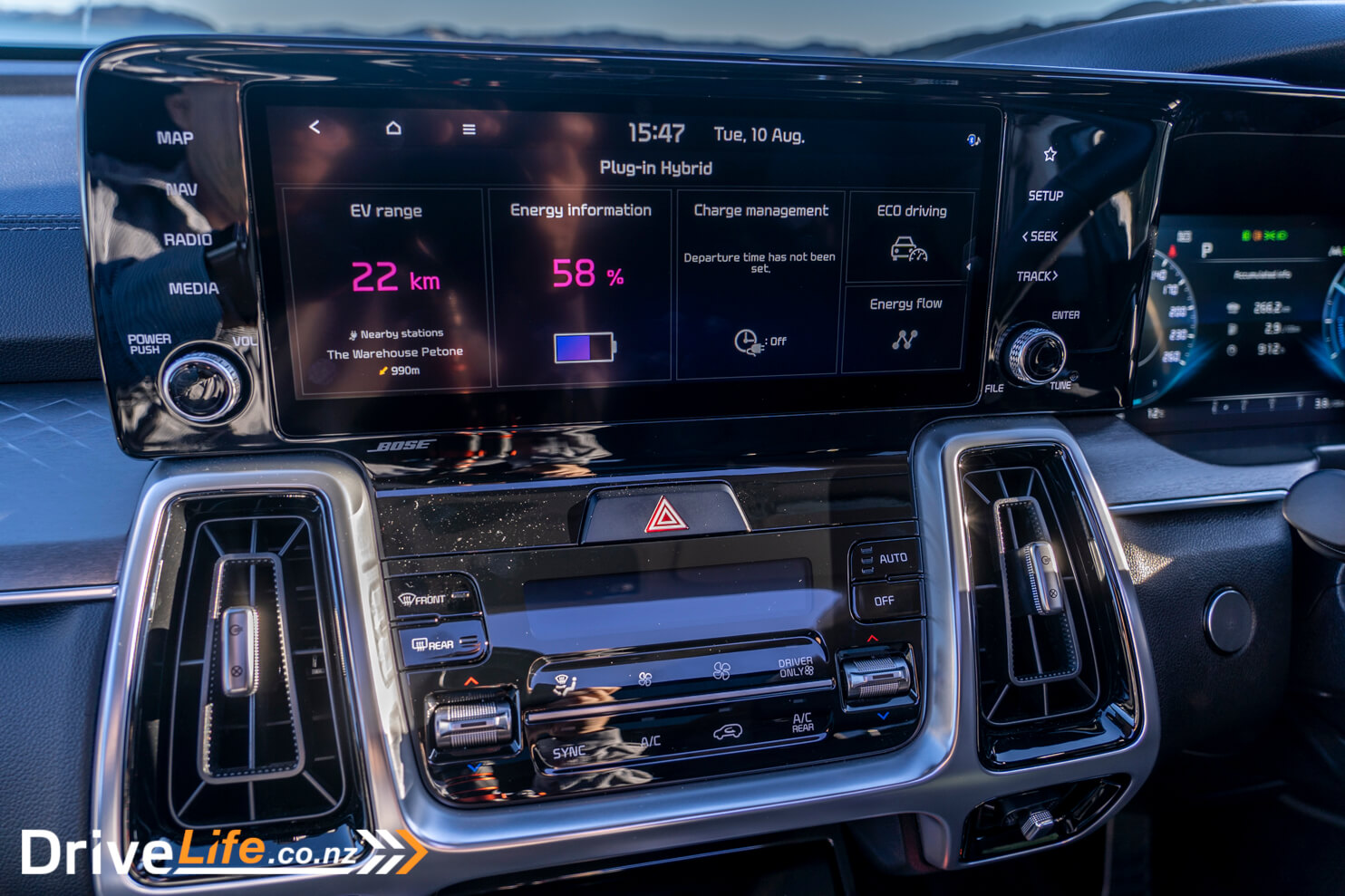
You get to pick from 3 PHEV modes in this car; Auto, Hybrid, and EV. As you’d expect, Auto just does its own thing, and decides what the car should do with regards to battery/engine, and this is really the best option for most people. Hybrid mode starts the engine and charges the battery up while driving the wheels. EV mode will force the car into using the battery only – or so you’d expect. If you have the car in EV mode and turn the AC on, very likely the engine will start. If it doesn’t start straight away, it will crank up in a few minutes or less. We’ve seen this with other PHEVs, like the Outlander and Toyota’s Prius Prime. While we understand that AC sucks out a lot of power, it’s a real shame that the engine needs to start to cope with the power draw.
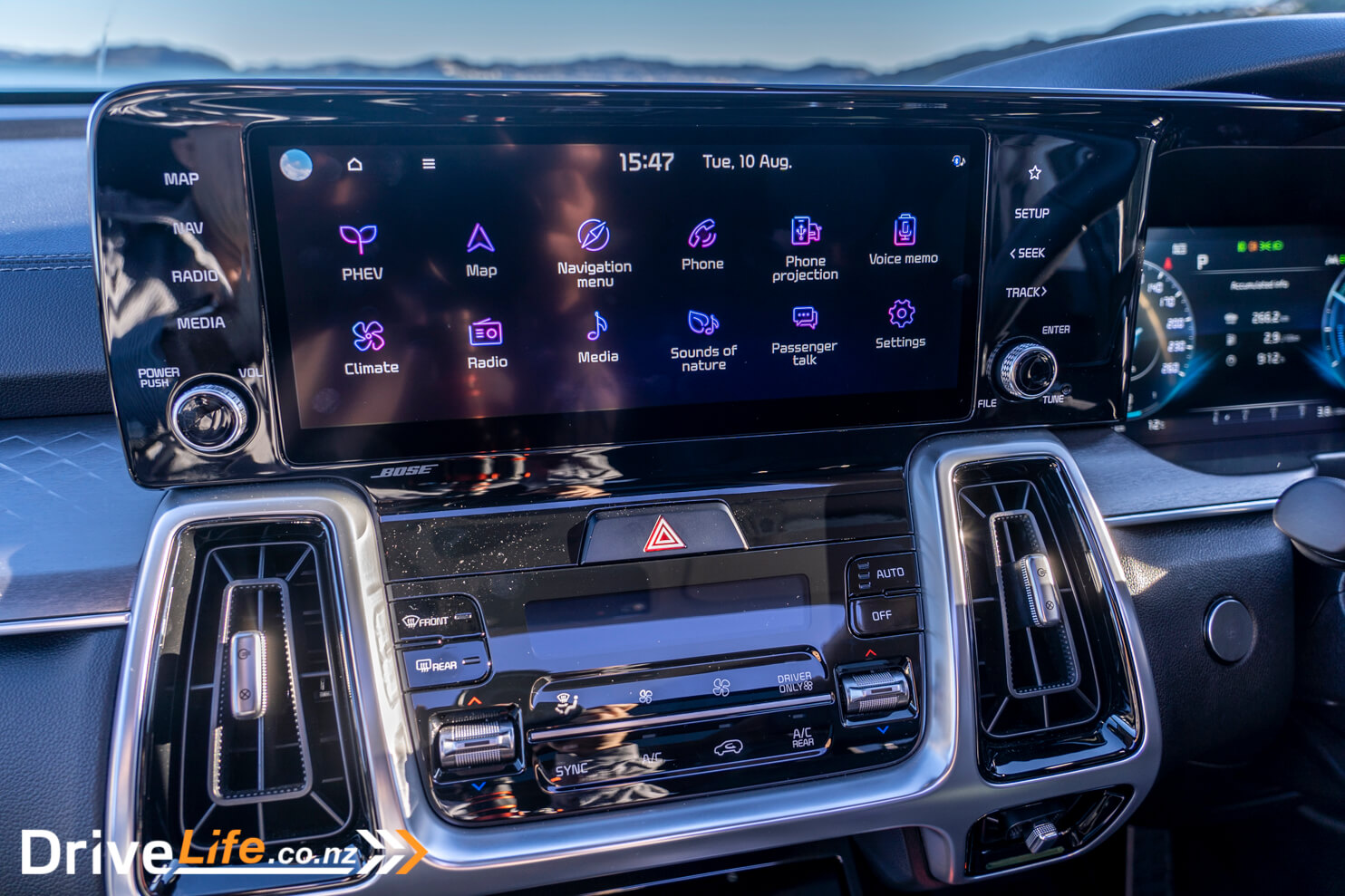
The AC system does have a ‘driver only’ button so this saves some power, but the engine will still startup, using precious fuel. To give the car a fighting chance for fuel economy, I left it in Auto mode for the week but stuck to using the heated seat most of the time instead of AC.
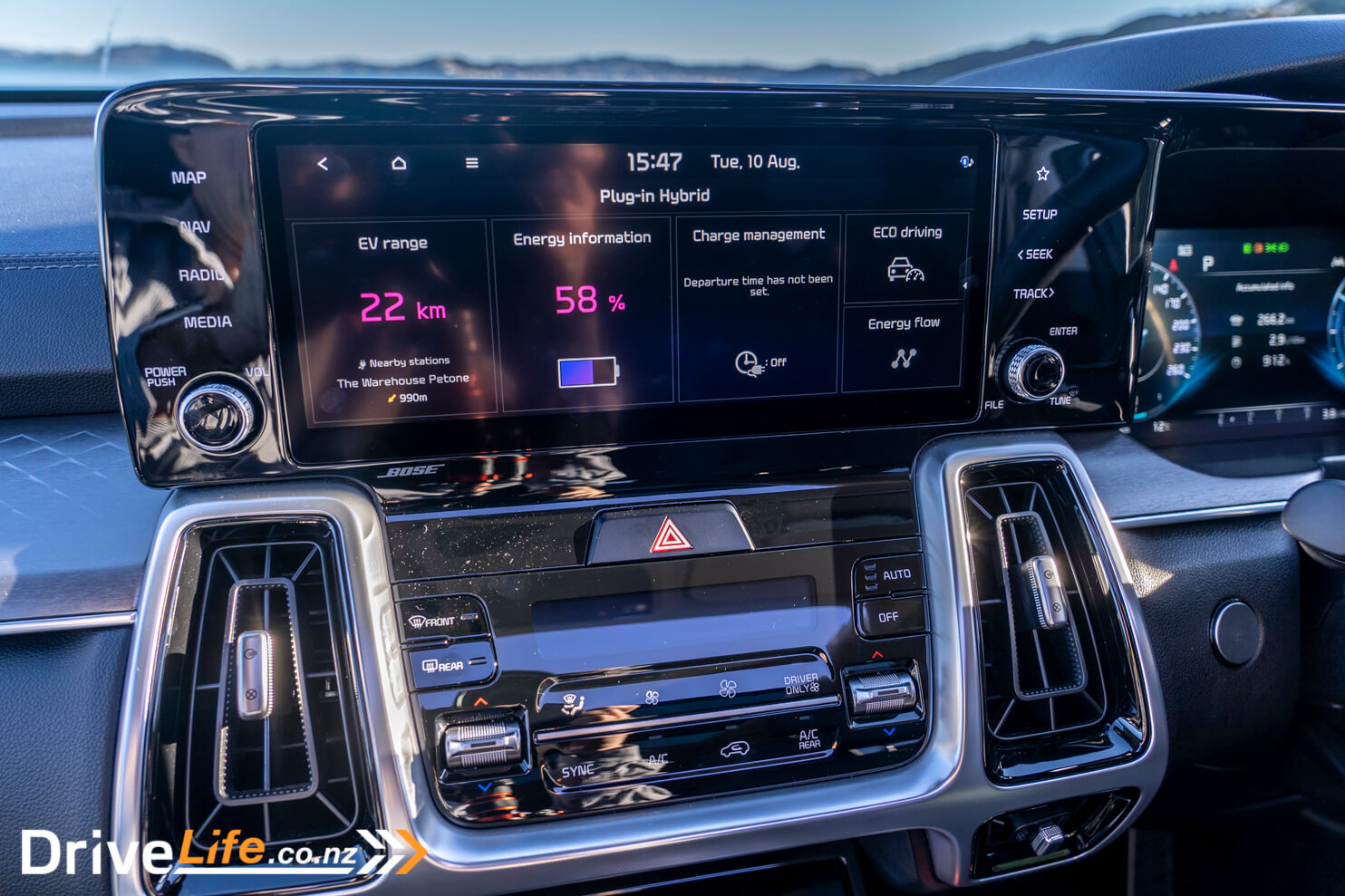
But of course, for my week with the car, it was bloody cold, so I still reverted to warming up using the seat, heated steering wheel and on some days, the AC. I charged it up every night that I used it, and after a week handed it off to Rob Clubley to test out. Rob wasn’t able to plug the car in each night – the Sorento simply wouldn’t fit down his driveway, too wide – so this would add some more real-worldness to the test. How did it go for fuel economy? Like a good book, you’ll have to wait to the end to find out.
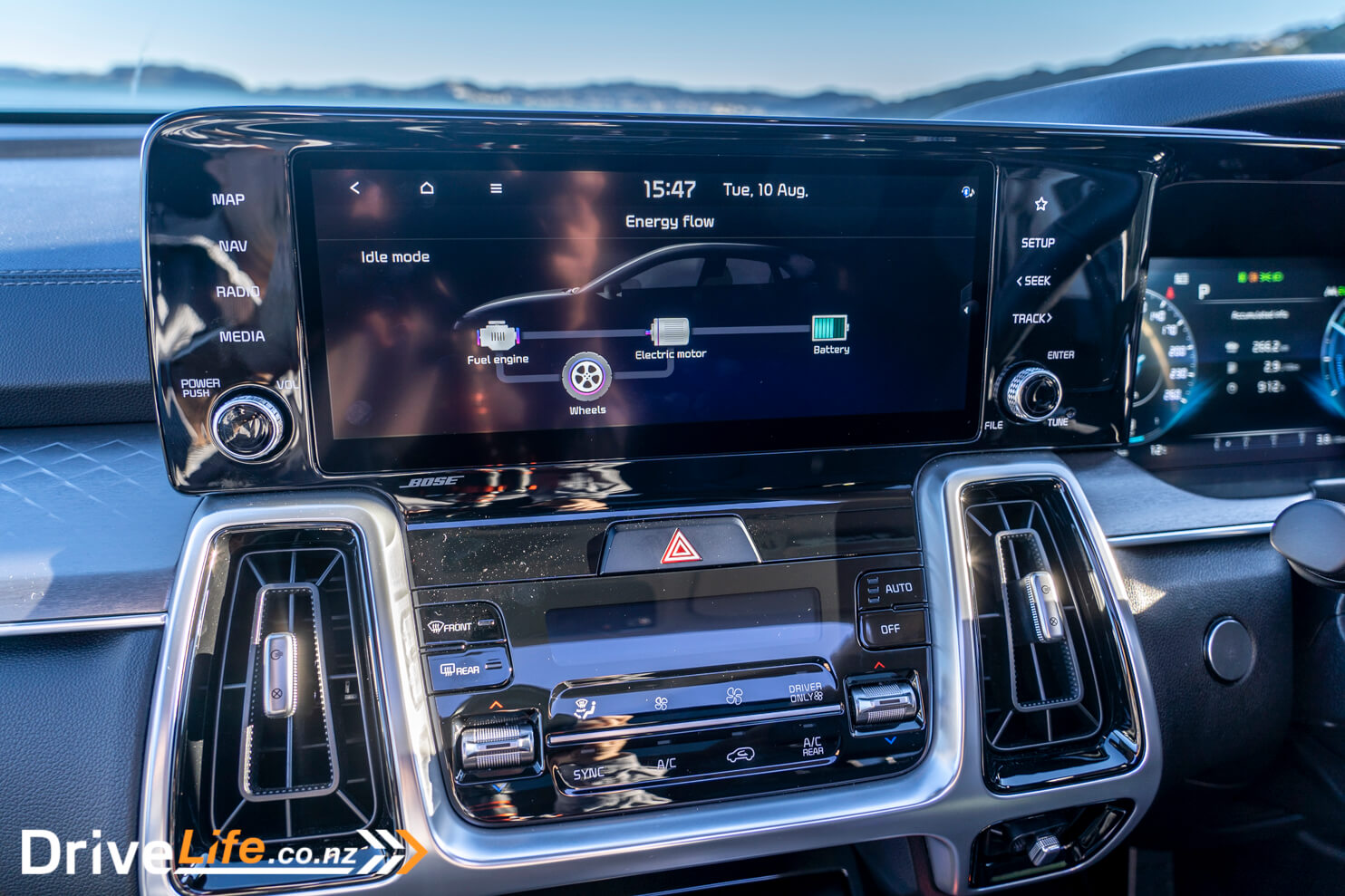
As well as the PHEV modes, there’s also 4 Drive Modes: Comfort, Sport, Smart, Eco. You turn the Drive Mode knob to change the modes, and then push it in to select from the available Terrain modes which are Snow, Mud, Sand. Yes, the Sorento PHEV is all-wheel drive, which will make it a great ski-trip car.
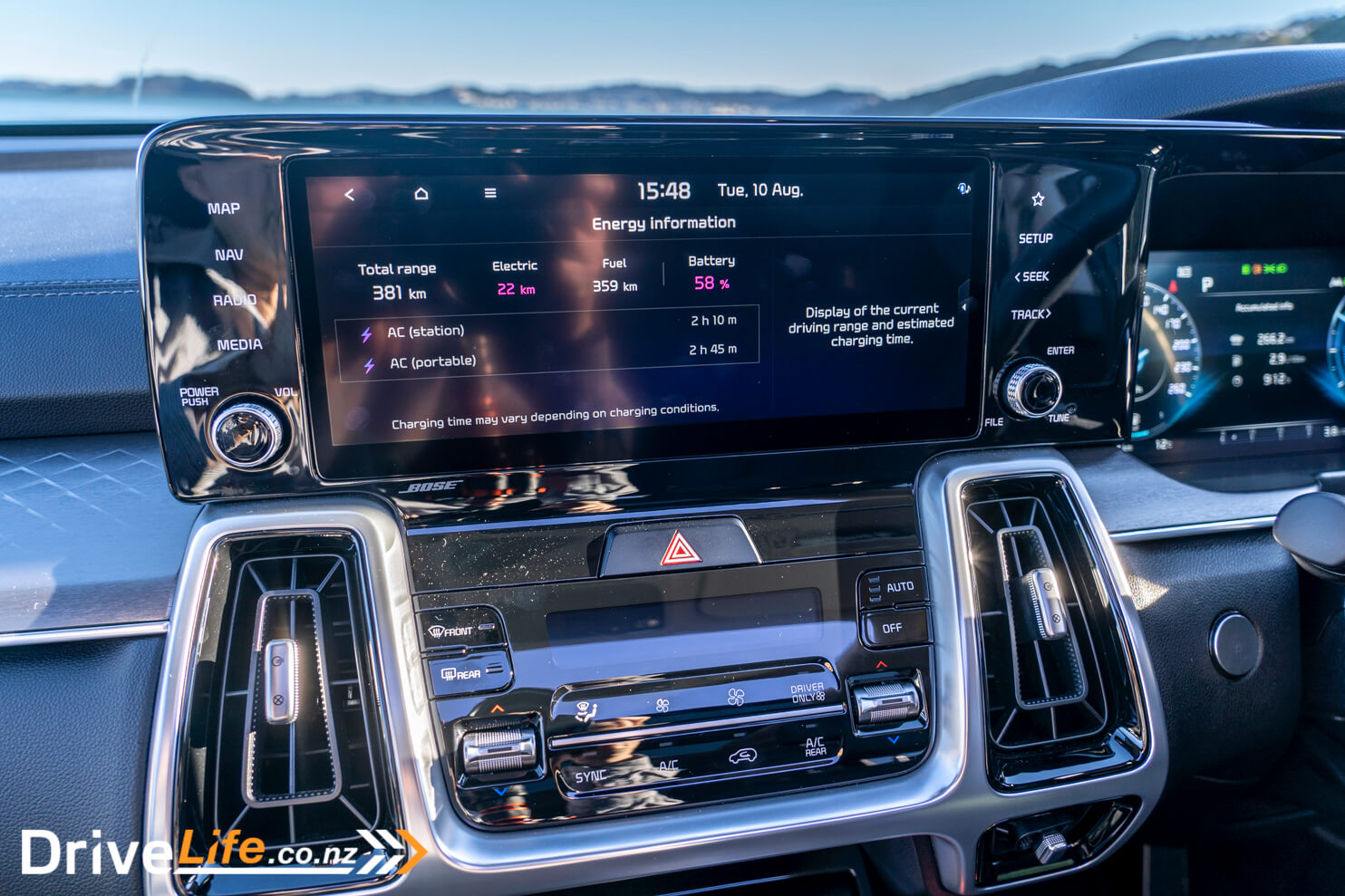
As a testament to its buyers, the car always starts in Eco mode, even if you have changed it to something else before parking up. That’s not the end of the world, as it’s plenty grunty enough in Eco just driving in EV mode, and if you have the engine running, even more so. With a combined power output of 195kW and a combined torque rating of 350Nm, the Sorento PHEV accelerates very well. While the battery pack makes it 150Kg heavier than the diesel models, I must admit I was surprised every time I drove the Sorento PHEV; for a 1.6-litre engine, pick-up is good and Kia have made the most of combining power outputs from EV and the petrol engine to make sure this car keeps up with traffic, and it does just fine. It also surprised many passengers that the car has a 1.6-litre engine. Make no mistake, this is a large SUV that weighs in at over 2,000Kgs.

On its own, the 4-cylinder turbo-petrol engine puts out 132kW/265Nm. Around town on a gentle throttle and with the engine running, it’s quiet enough. On the motorway it’s almost silent, which is pretty much on par with every other modern engine. Up hills under heavy load, the engine can be more vocal, but I’ve heard worse. It’s never intrusive, and at this price point, you wouldn’t want it to be.
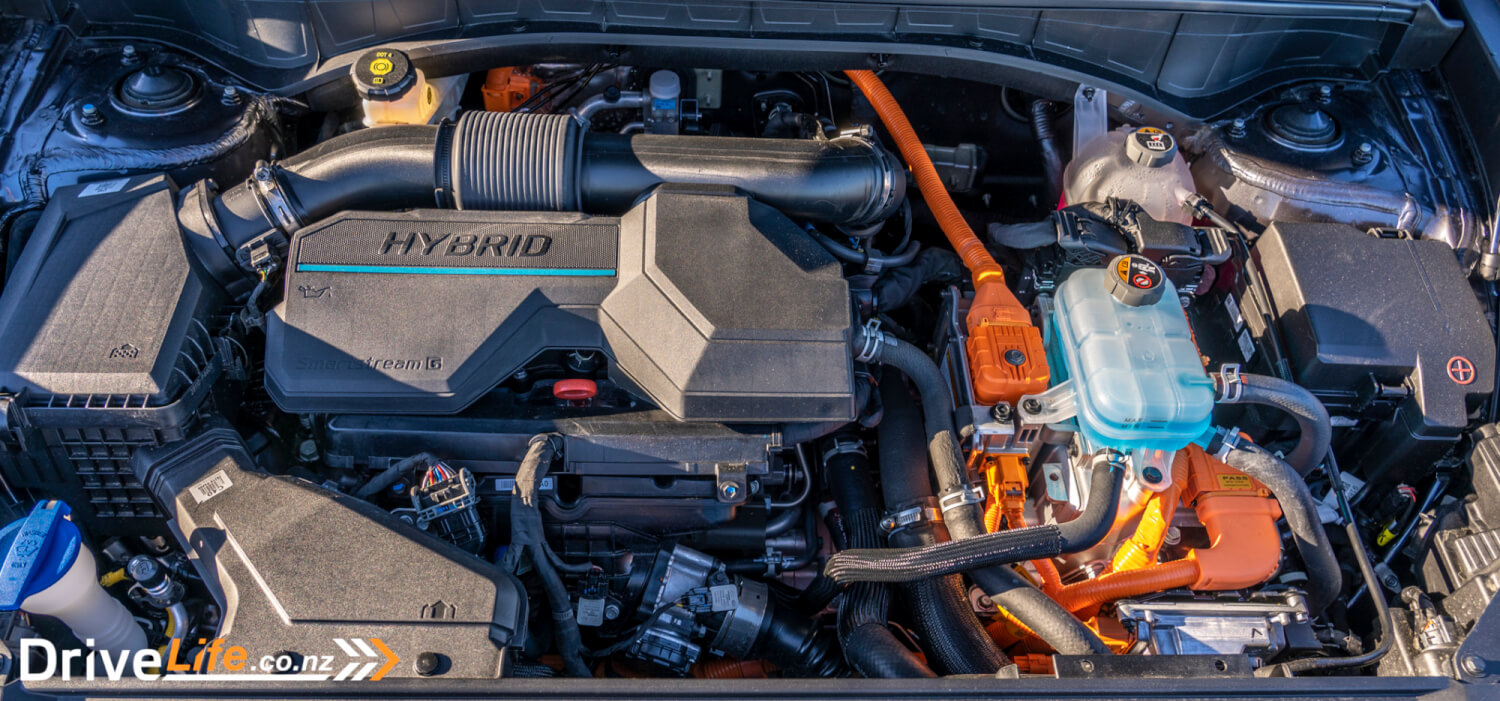
There are steering wheel paddles for what you would think is brake regen, since that’s what paddles shifters are for on most other PHEVs. But not the Sorento PHEV. For some reason, instead of increasing or decreasing brake regeneration when using the paddles, using them will start the engine up and change up/down a gear. I got caught by this a few times, and after that didn’t bother using them at all. I found this really strange, and we’ve gotten used to these being an effective way to gain some extra charge down a hill, as well as using the brakes if needed. Often you can simply use the paddles to slow the car, and not touch the brake pedal. To turn the engine off and revert to EV mode, I’d have to hold down the right paddle for three seconds until the car went back into Auto mode for the gearbox, and then the engine would turn off (if there was enough battery charge). This scenario even occurs in EV mode.
Once that engine starts up, it can either charge the batteries if they need it, or if you push the gas pedal hard enough, it will drive the front wheels and charge the batteries. Other times it just drives the front wheels.
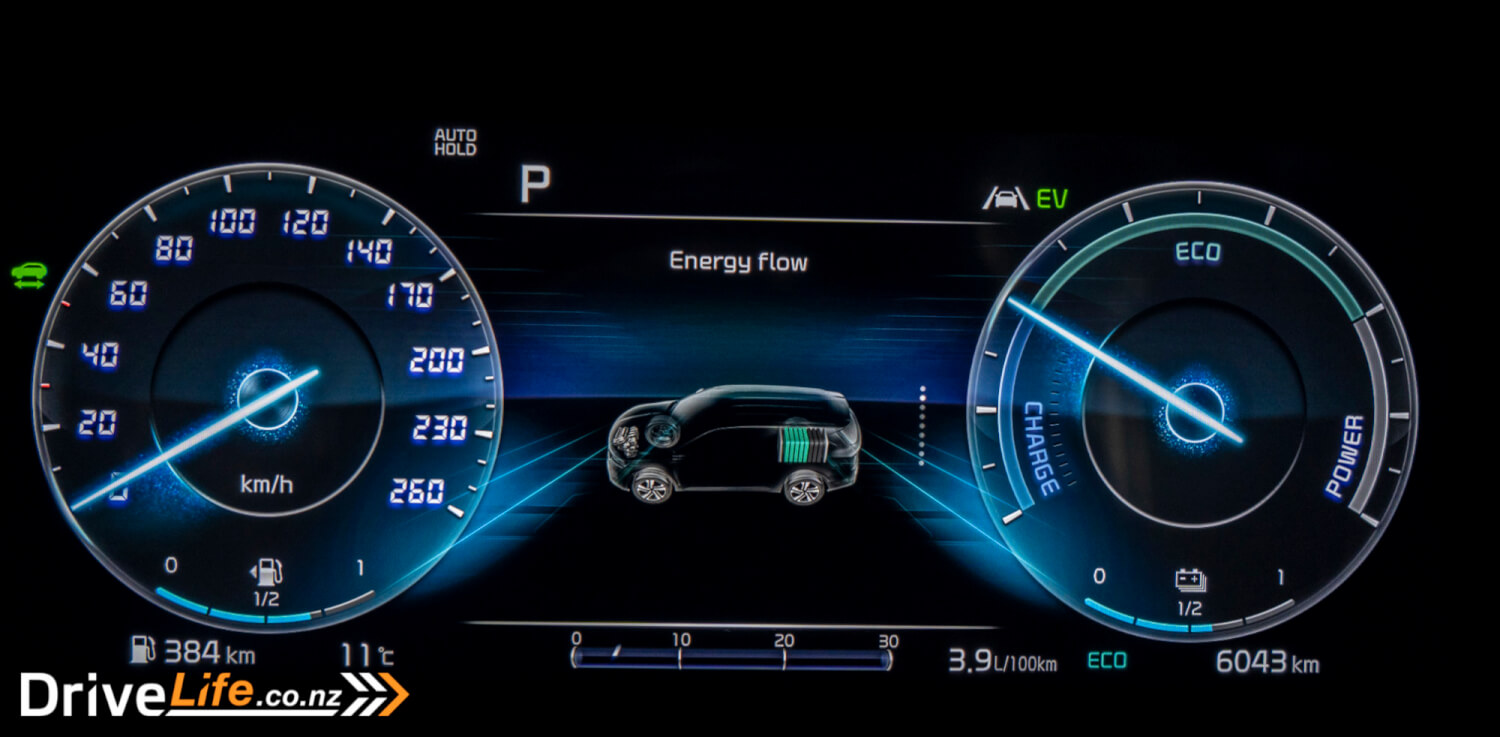
When I plugged the Sorento PHEV in each night, I found that there’s no charge port light. At first, I fumbled around in the dark trying to get the plug in, and then resorted to using the torch on my phone. Other PHEVs have a charge port light, so I have no idea why this $90K car doesn’t. Another slight anomaly: The car has the petrol flap on one side, and the power flap on the other. This isn’t an issue at all, but while the fuel gauge has the normal arrow on it to show which side the filler is on, the battery meter does not have any arrow. Yes, you can work it out by looking at the fuel gauge, but it seems such a simple thing to do, and would sort of be quite cool to have an arrow for each. In the morning there’d be around 46Km or less EV range. While Kia suggests you might get up to 57Km range on EV only, Wellington’s hills mean it’s always going to be less than perhaps in a place like Christchurch.
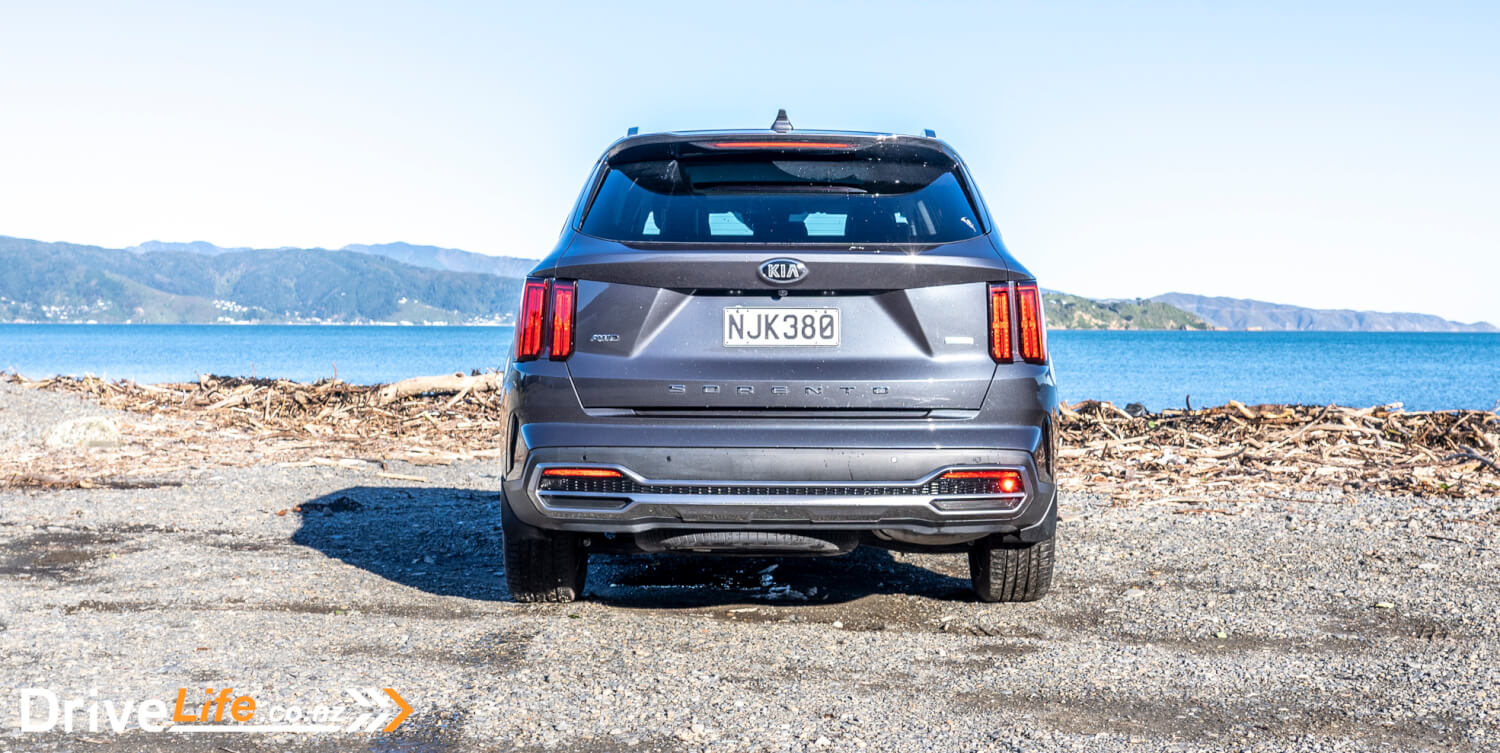
I didn’t drive the Sorento diesel, so can’t really compare but the ride on the PHEV version is very good, perhaps that extra weight helping it along. The chassis on these cars – the same chassis as the Santa Fe which I have reviewed – is excellent, and you can do a reasonable job on a windy road, if you wanted to. It grips and handles very well. Like the diesel version, this PHEV has a rotary gear knob. It works okay, but more than once I found the car still in Reverse when I thought I had selected Drive. This gave me a fright a few times, so I was more cautious and deliberate in selecting a gear after that.
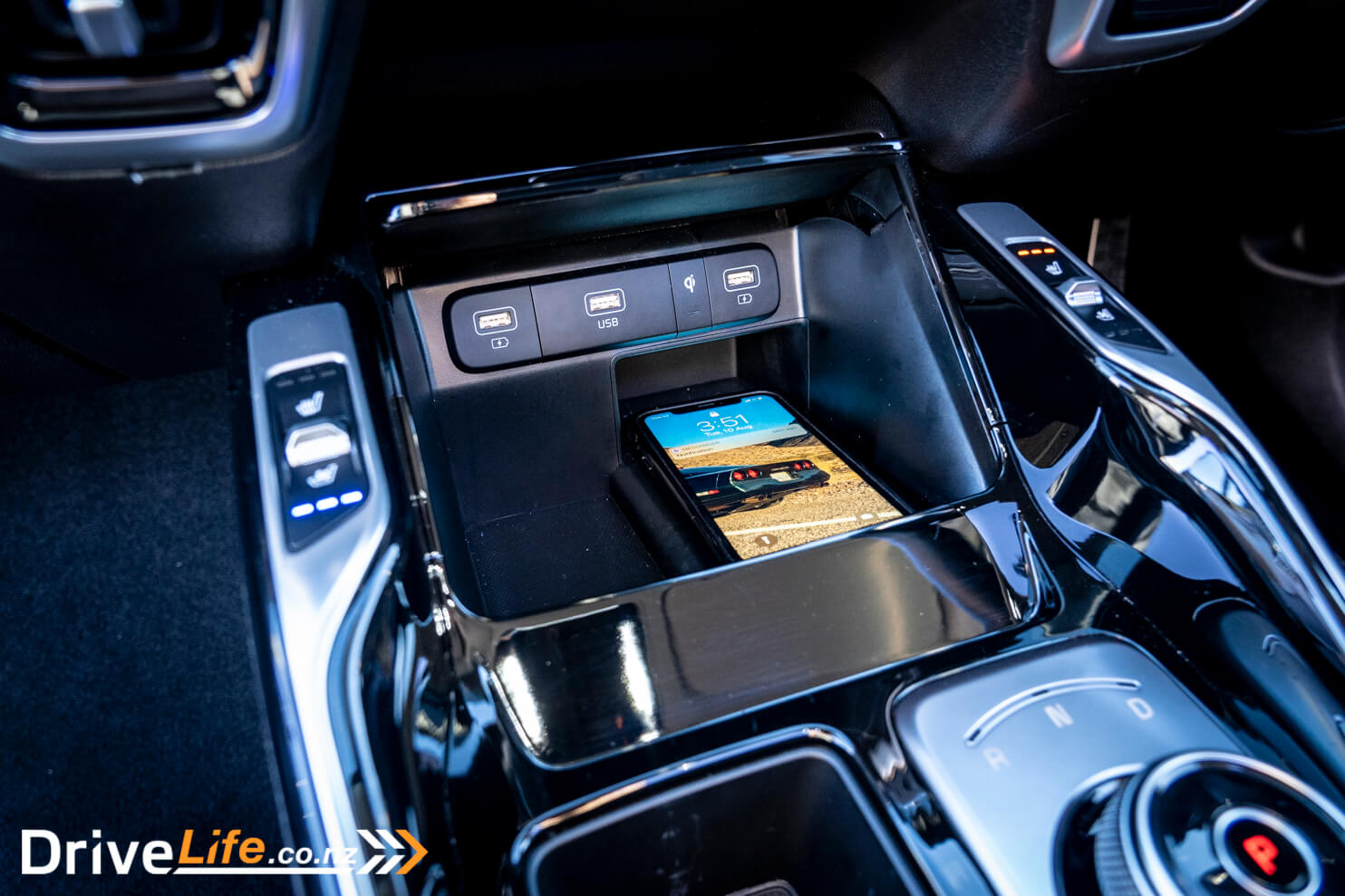
A surprising omission in this Sorento is the lack of traffic sign recognition. Instead, Kia offers the Manual Speed Limit Assist feature, but it’s not the same as the centre display (on Maps), the driver’s information display or the heads-up display showing the actual speed limit.
On the plus side of things, the HUD is excellent, and it’s great to see the car has sliding sun visors. I really wish all manufacturers would put these in their cars, it makes driving in the sun so much safer. The Bose Centre Point audio system with Surround Technology is well above average and should please most buyers. The seats need more side support upfront; they are comfortable enough, but on a windy road I found myself sliding left and right, and that’s never a good thing.
Weirdly, the new Sorento doesn’t have wireless Apple CarPlay or Android Auto; The $30K Kia Stonic we reviewed in May did have this, so it was surprising to see this new, far more expensive Kia does not.

I do love the haptic steering wheel – well done Kia. This means that if (for example) you are reversing out of a driveway and there’s traffic coming from either side behind you, the steering wheel will vibrate to alert you. The car beeps too of course, but if you had noisy kids in the car at the time, you might not hear that. It does this on the motorway too if you go to change lanes and there’s a car there, or for rear cross-traffic alert. It’s a great system. I can see a few people getting a fright the first time it happens, but I expect buyers would get used to it quickly. It could save a life or at least prevent a crash.
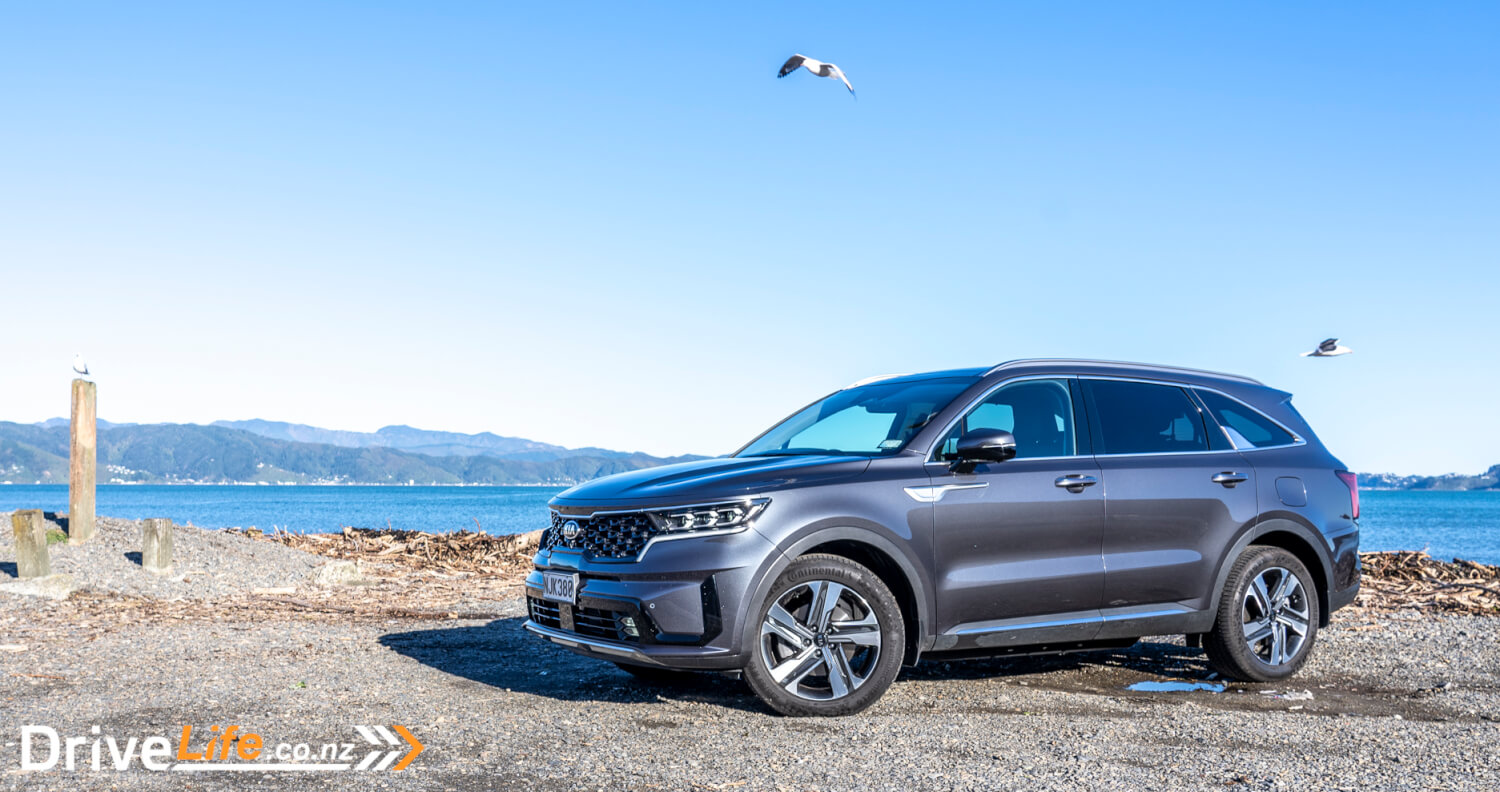
So, what about fuel economy? Kia suggests that the car should use 1.6 litres of petrol per 100km. I mentioned that Rob couldn’t plug the car in to charge at night; before I handed the car over to him, my fuel economy was sitting at 2.8L/100Km – more than Kia suggests, but for me pretty bloody good considering the size and weight of this car. After 430Km total driving with Rob’s usage, fuel economy averaged out at 4.4L/100Km – still very good for such a large SUV. And what about the range? The car still had 209Km of petrol range left so the estimated total range was 639Km. That’s a lot more than was suggested when I picked the car up, which was 468Km.
Plugging in any PHEV every night is the way to go if you want max fuel economy, but even with our mixed usage, 4.4 is a good result.
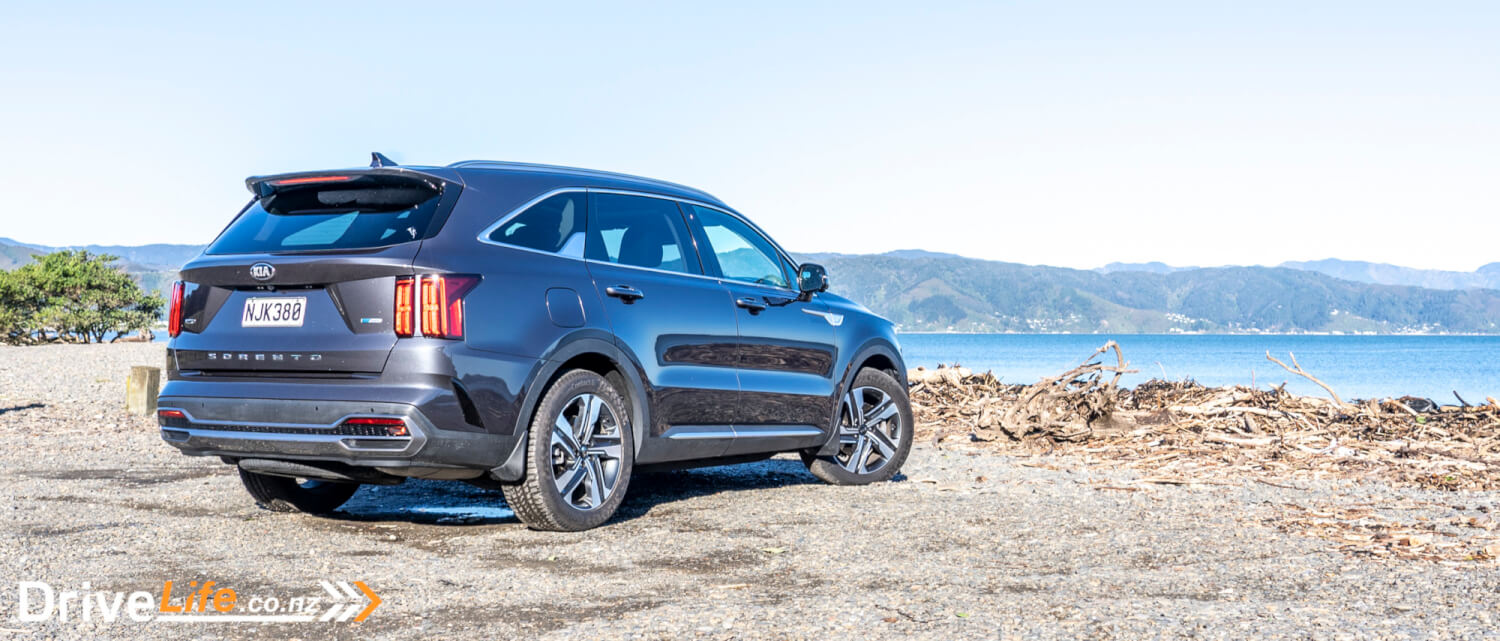
What Is The Competition For The 2021 Kia Sorento Premium PHEV?
Want yourself a 7-seat plug-in hybrid or even just a 7-seat hybrid? If you’re looking to pay less than $100K, it’s pretty slim pickings out there at the moment, with only the Kia Sorento PHEV available.
As mentioned, the Mitsubishi Outlander PHEV is only a 5-seater SUV, and it’s on runout at the moment. While that makes it great value, when that model has gone, it’s gone.
Obviously, the Skoda is a station wagon, but I’ve included it just to try and get another model on the table and it’s a hell of a roomy wagon.
| Brand/Model | Engine | Power/Torque kW/Nm | Seats | EV Range, Km | Cargo capacity, L | Fuel L/100km | Price |
| Kia Sorento Premium PHEV AWD | 1.6-litre, 4-cylinder turbocharged petrol/plug-in hybrid | 195/350 | 7 | 57 | 608 | 1.6 | $89,990 |
| Skoda Superb iV Sportline | 1.4-litre, 4-cylinder turbocharged petrol/plug-in hybrid | 160/330 | 5 | 62 | NA | 1.7 | $79,990 |
| Mitsubishi Outlander PHEV VRX | 2.4-litre, 4-cylinder petrol/plug-in hybrid | 94/199 | 5 | 59 | 463 | 1.9 | $59,990 |
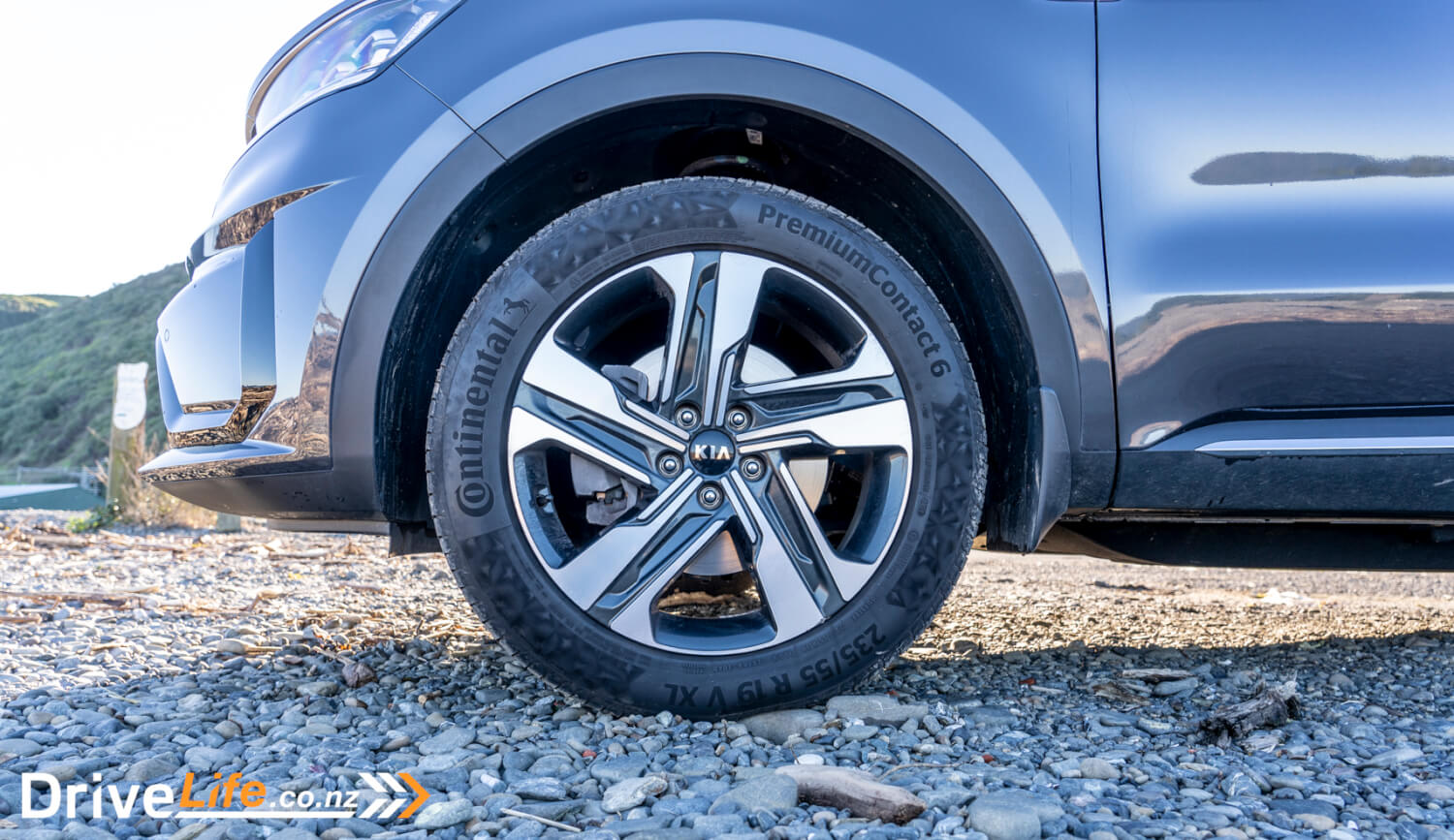
What The Pros and Cons Of The 2021 Kia Sorento Premium PHEV?
| Pros 7-seat PHEV Fuel economy Fit and finish; overall quality Materials and textures used inside Handling/grip Ride Equipment levels Ventilation Performance Currently in a market segment of its own Haptic steering wheel Audio quality | Cons Price No charge-port light Paddles don’t affect regen No traffic sign recognition No wireless Apple CarPlay/Android Auto |
| Vehicle Type | 5-door large SUV |
| Starting Price | $89,990 |
| Price as Tested | $89,990 |
| Engine | 1.6-litre, 4-cylinder turbocharged petrol/plug-in hybrid |
| Power, Torque kW/Nm (combined) | 195/350 |
| Transmission | 6-speed automatic |
| Spare Wheel | Full-size alloy |
| Kerb Weight, Kg | 2,057 |
| Length x Width x Height, mm | 4810x1900x1700 |
| Cargo Capacity, litres Seats up/seats down | 175/604/1988 |
| Fuel capacity, litres | 47 |
| Fuel Efficiency, L/100Km | Advertised Spec – combined – 1.6 Real World Test – combined – 4.4 Low Usage: 0-6 / Medium Usage 6-12 / High Usage 12+ |
| Towing Capacity Kg, unbraked/braked | 750/1,350 |
| Turning circle, metres | 11.6 Small: 6-10m / Medium 10-12m / Large 12m+ |
| Warranty | Four-years/ 40,000km scheduled servicing included Five-year new car warranty Five years Roadside Assist Seven-year battery warranty |
| ANCAP Safety Ratings | 5 Star |


